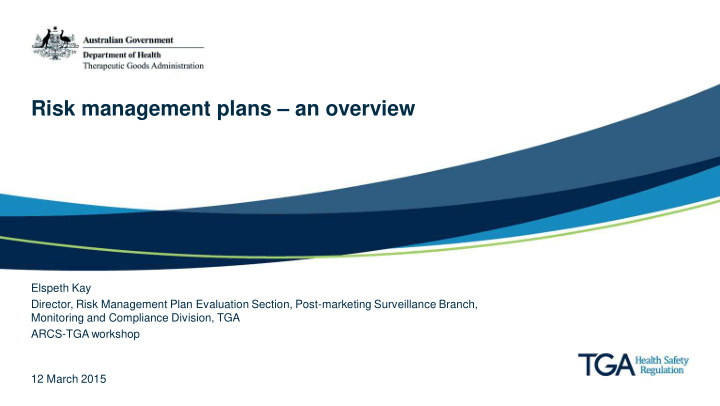



Risk management plans – an overview Elspeth Kay Director, Risk Management Plan Evaluation Section, Post-marketing Surveillance Branch, Monitoring and Compliance Division, TGA ARCS-TGA workshop 12 March 2015
Outline • What are RMPs and why are they needed? • How does the TGA evaluate RMPs? • Guidance on developing RMPs Risk management plans – an overview 1
Why have RMPs been required? • Limited information from clinical trials (CTs) • Not always representative of real world usage due to inclusion and exclusion criteria in CTs • Potential risks identified but not fully characterised during CTs • Missing information in certain population groups – children, pregnant women and the elderly Risk management plans – an overview 2
What is a risk management plan for? Outlines the risk management system for a medicine once it is available for use in Australia. Comprises: • Known safety profile • Identified and potential safety concerns and where appropriate how they will be mitigated • Missing safety information where this is known or can be predicted and how this will be managed Focuses on: • Monitoring – Pharmacovigilance Plan • Minimising risks associated with the use of the product – Risk Minimisation Activities Provides: • Coverage of the life cycle of the product • Assurance that all risks related to the use of a medicine have been considered and acted upon Risk management plans – an overview 3
Risk minimisation activities • Routine risk minimisation activities include • Additional risk minimisation activities include • Product Information • Education programs for patients • Consumer Medicines Information • Health care professional education programs • Directions for use document • Dear Health Care Professional letters • The labelling • Controlled access programme • The pack size and design • The legal (prescription) status of the product For each safety concern a risk minimisation activity is assigned in the RMP Risk management plans – an overview
Pharmacovigilance Plan • Routine pharmacovigilance includes • Additional pharmacovigilance includes • Collection, follow-up and reporting of • Clinical trials adverse events • Post-authorisation safety studies • Analysis of data and reporting in Periodic • Drug utilisation studies Safety Update Reports (PSURs) • Patient registries • Physician surveys • Prescription event monitoring For each safety concern a pharmacovigilance activity is assigned in the RMP Risk management plans – an overview
The RMP evaluation team Risk management plans – an overview 6
Post-market surveillance branch Dr Jane Cook Device vigilance and Signal investigation Risk management plan (medicines) evaluations monitoring Technical projects and Recalls and advertising Advisory committees communications Risk management plans – an overview 8
RMPs to date Year Number of RMPs evaluated 2009 8 2010 70 2011 50 2012 82 2013 131 Risk management plans – an overview 9
Workflow of a RMP evaluation 10 Risk management plans – an overview
Updated Q&As and ASA • Proposed updated Q&As and ASA template sent to Medicines Australia and GMIA for members’ comment (Nov 2014) • Main themes of feedback Reduce duplication Clarify process • We have amended Q&As and ASA template in response to your feedback Risk management plans – an overview 11
Guidance • RMP Questions and Answers • Australian-specific Annex Template • Mandatory requirements for an effective application • EMA Guideline on good pharmacovigilance practices: Module V – Risk management systems • RMP co-ordinator (rmp.coordinator@tga.gov.au) Risk management plans – an overview 12
RMP requirements in Australia • TGA follows EMA RMP guidelines • RMP submitted should be the most recent EU-RMP • Core RMP with ASA or Australian RMP acceptable if no EU-RMP exists 13 Risk management plans – an overview
Tips for a smooth process • Make sure all the information asked for in the ASA template is provided • There is no “one size fits all” approach – judgement required • Provide all documents referred to in the RMP and ASA • Whenever there’s an update, state clearly what has changed and why • Provide all required information at submission or at s31 response • Address all RMP evaluator recommendations • No submission of data during evaluation unless requested by TGA or by prior agreement Risk management plans – an overview 14
Recommend
More recommend